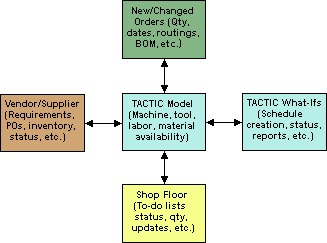TACTIC Data
 Because you can interact with TACTIC to provide data that may not be readily available for transfer from other systems (i.e., your intuition substitutes for the data), TACTIC only needs minimal amounts of data to assist the what-if problem solving process. With minimal amounts of data, you can configure TACTIC to help create schedules, try what-if ideas, update schedules, and communicate with others.
Because you can interact with TACTIC to provide data that may not be readily available for transfer from other systems (i.e., your intuition substitutes for the data), TACTIC only needs minimal amounts of data to assist the what-if problem solving process. With minimal amounts of data, you can configure TACTIC to help create schedules, try what-if ideas, update schedules, and communicate with others.
Data needs
- Capability Data - can include machine, tool, labor, vendor, and material availability. It can also include changes to the availability of these items.
- Requirement Data - can include orders and their associated routing operations, bill-of-material, and item master relationships. It can also include changes to these items and relationships.
- Status Data - can include progress against completing scheduled routing operations.
Data use
You use the capability data to describe your capacity and material limits to TACTIC, and also any changes. This data lets you simulate: normal time, overtime, vacations, absenteeism, machine downtime, tool downtime, actual and planned inventory allocation priorities, vendor delays, etc.
You use the requirement data to describe to TACTIC how orders consume your limited capacity and limited material. This data lets you specify part specific information such as: run times, setup times, overlap, shelf life, batching, splits, and other processing constraints; multiple machine, tool, labor, and material constraints and also their alternates; bill-of-material, safety stock, sites, and cost relationships.
You combine the capability and requirement data to create plans and schedules. You use the status data to update your schedules. You interactively change and add-to the data to ask what-if questions (i.e., add your intuition) to resolve problems. You display, transfer, and report the data and its resulting changes to manage the interactive what-if problem solving process.
Data transfer
Some management teams integrate TACTIC with their business and other systems, to reduce the need for manual or double data entry, and also to better use their valuable data. For example, order, bill-of-material, item master, and inventory data might be held in an accounting or an ERP/MRP II system; routing and tool information might be in an engineering database; maintenance requirements might be held in a maintenance system; labor availability might be in a time and attendance system; planned shift and vacation schedules might be in a spreadsheet.
Other teams operate TACTIC as a standalone planning, order promising, scheduling, and capacity management tool. They manually enter their formal and their informal capability, requirement, and status data.
Still other teams integrate TACTIC to obtain readily available data, such as orders from an accounting system, while manually providing other data, such as shop floor status. At such time as the data or data gathering are improved, they often integrate the systems more tightly.
Data integration
 When integrating TACTIC, many management teams want to electronically transfer data stored in different systems and applications and also in different formats, including non-structured formats, such as reports. They may even want to include some critical data that might be held in people's heads or in their personal notes.
When integrating TACTIC, many management teams want to electronically transfer data stored in different systems and applications and also in different formats, including non-structured formats, such as reports. They may even want to include some critical data that might be held in people's heads or in their personal notes.
For those reasons, TACTIC allows you to link to many different personal computer, minicomputer, and mainframe platforms - without the need to write code. You can extract and transform data from, and also provide data in, many different formats (e.g., SQL and ODBC databases, spreadsheets, binary and flat files, non-SQL databases, ISAMs and record managers, and ASCII files including HTML and XML). In addition, you can add-to your data during transformation to account for informal data and data held in personal notes.
TACTIC lets you graphical layout your data extraction and transformation projects. You can drag-and-drop extraction and transformation process steps to create a flowchart that automates simple, multi-step, and multi-source transformations. Once your project is designed and tested, TACTIC can execute it behind the scenes to provide seamless integration to and from multiple data sources.
